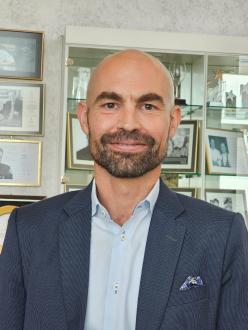The Quest for Seamless Onboarding and the Virtues of Aligning Technology with Pragmatism & Agility

Nov 20, 2023
Is the wealth management industry at risk of being significantly hampered by excessive regulatory compliance? Yes, it is. Hubbis and our partner for the event, Swiss financial consulting boutique finalix, hosted a private but in-depth conversation on ‘The Future of Onboarding’, to pinpoint the critical challenges encountered by private banks and wealth management firms, and explore ways for the industry to streamline and expedite the client onboarding process. The discussion was attended by 14 key private bank, EAM, MFO and technology decision-makers, and among them was Dr. Andreas Wenger, partner at Finalix Business Consulting. Andreas was not there to steer the proceedings or provide definitive answers; but rather to actively engage with industry experts and welcome their candid, off-the-record insights on key issues in client onboarding. Despite significant advances in digital solutions, the Onboarding challenges persist and demand significant time and financial resources that lead to substantial operational headaches for the intensely regulated banks. The consensus among guests was that despite strategic efforts and digital advancements, the industry continues to struggle to keep up with regulators, both locally and globally. They emphasized the necessity for banks to improve internal processes and adopt an agile and collaborative approach to data gathering, while being pragmatic and acknowledging that there are no perfect solutions. Technology, while beneficial, isn’t a panacea and must be aligned with the right approach, people, skills, and attitudes. We live in an imperfect world, and while regulators might set huge demands for the wealth industry, the reality is that business must go on, so banks need to be aware that there are real risks of ‘death by endless box-ticking’ that others and themselves can mitigate and at least partially overcome. This is a summary of the key hurdles they articulated, and some of the current and pending solutions that will mitigate, but realistically not entirely overcome these challenges.
A Short Note on finalix and Andreas Wenger
Since 2001, Finalix Business Consulting has made a name for itself working for a wide range of financial service providers, such as universal banks, private banks, asset managers, private equity corporations, and insurers. The company focuses on digitalisation and transformation projects, covering key senior roles on the business side.
After significant success in Switzerland and Europe, the firm set its eyes on Asia and opened Finalix Pte Ltd in Singapore in 2019. This move was driven by the demand from its existing Swiss and European client base, and the motivation to offer further geographic diversification to employees and business partners. Since then, finalix Singapore has expanded to serve local and regional Asian banks as well.
Andreas Wenger joined the Singapore operation in 2020, moving from IMTF, a leading Swiss RegTech provider focusing on Client Lifecycle Management. Andreas has fifteen years of experience in consulting and financial services and has been at the forefront of finalix’s expansion effort in the region.
He believes onboarding is immensely critical to success in wealth management and in a recent Hubbis article, explained what he means by a ‘holistic’ approach to onboarding.
Key Takeaways in Brief
In the realm of private banking and wealth management, client onboarding presents ongoing challenges. Despite technological advancements, there's no one-size-fits-all solution. Verifying identity is easier than determining the source of wealth, which often requires historical investigations. Compliance demands are relentless, with ever-evolving regulations and jurisdictional variations, especially in high-net-worth and ultra-high-net-worth private banking.
Achieving the right onboarding experience is pivotal and has a major influence on clients and EAMs’ decision to start a relationship with a bank. As a result, RMs and client advisors prefer to join or stay with banks that have a faster and more efficient onboarding. This is often the first question they ask if they are being headhunted.
Efficient, collaborative, and adaptable onboarding solutions are crucial. Technology, while vital, must seamlessly integrate with refined internal processes and communication. Striking a balance between operations and business objectives is imperative for a bank's longevity. Improving internal processes and fostering better communication are pivotal, and proactive management practices encourage a realistic approach by dissolving organizational silos.
Compliance teams, often constrained by rigid checklists and excessive defensiveness, may overlook common-sense solutions. Balancing regulatory demands with practicality is essential, given different regulators' priorities leading to jurisdictional arbitrage. Experienced talent streamlines the process but is expensive and in short supply, posing challenges for banks in recruitment and retention.
Additional solutions for comprehensive ID, source of wealth, and KYC data involve centralized government agencies and data hubs. However, these may not be feasible for global HNW and UHNW clients, raising concerns about data ownership, security, and accountability.
In summary, perfect KYC and source of wealth verification may be unattainable, emphasizing the need for improved internal processes, communication, and pragmatic top-down approaches. Experts call for common-sense thinking, teamwork, and collaboration, bolstered by technological advances from the FinTech, RegTech, and data management sectors.
Key Insights & Observations in More Detail
It is not only the banks that face onboarding challenges; EAMs also help with numerous account openings for their clients, but their clients still face the same bumpy or perhaps troubled journeys with virtually all of them
Commenting on the dramatic changes to onboarding protocols she had witnessed in the past nearly two decades, an EAM head in Singapore said that it was a mixed bag of client onboarding experiences with the 20 or so custodian banks they work with.
“There are significant differences between them, some might be a bit more streamlined, but barely any banks can guarantee rapid account opening or a smooth ride now,” she reported. “They are all regulated the same by the MAS but actually we find all their approaches are different. It begs the question as to whether it is [due to] different management styles, compliance team interpretations, resources, technology or all the above.”
EAMs do not make money from client account onboarding with the custodians, so they will tend to follow the path of least resistance
She explained that although there are no banks that offer a perfect experience, the EAMs will naturally gravitate towards banks which make this relatively simpler and faster. “We will naturally take the path of least resistance,” she said. “This means onboarding offers a significant competitive edge for those banks that perform better.” She added that the outcomes in this regard are changing constantly, as some banks become worse, and others improve.
Fixing (at least in part) or remediating onboarding problems and practices is critical for banks and EAMs wanting to hire client-facing bankers and advisors
A banker said that any RM thinking of joining their bank asks about onboarding as one of their first questions. The same is true of most potential clients. “The reality is everybody is struggling with the same issue and faces quite similar issues,” he stated.
This is far from a one-time, one-off ‘opening’ problem; issues can arise at any time, even with long-established clients, making it even more frustrating for all. The problem is that compliance teams often operate in isolation from practical situations, and sometimes tend to impose excessive internal control.
Another EAM head who deals with around 12 custodians, mostly in Singapore, explained that compliance issues can come seemingly out of nowhere, even for clients onboarded years and years ago. He explained how a leading bank that onboarded one of their clients over a decade ago suddenly asked who had funded that client’s business back in the 1970s. “Who has records back from that era of more than 40 years ago?” he pondered. “Frankly, it is pretty stupid. We work under the same regulations as the banks; we should not face such stupid questions.”
He said the problems come from the compliance teams, often stocked with too many junior staff working on checklists. “Nobody tries to push back on anything on that checklist. And then when the MAS comes with new rules or guidance, as likely after they review this (current) Turkish and Cyprus money laundering issue, some banks will add 20% on top of that, or 30%, just to be a little bit more cautious or, more senseless, whichever way you look at it.”
He added that of course, KYC and AML must exist and be handled professionally, but what seems to be missing is common sense.
There are however nuances and different types of clients that can benefit from a more seamless experience
Another guest – a banker but from external compliance - remarked that for him, there are better experiences than the first two guests had indicated, and that the journey depends largely on the type of client and the experience and pragmatism of the account opening team. For instance, someone from Singapore opening an account in Singapore will get onboarded generally quicker than international clients coming to Singapore, or perhaps a foreign client banking in Singapore and wanting to also book in Geneva.
“Is it people or technology or resources?” he pondered. “Some of all, but the biggest driver is the experience in the banks and the resources the banks allocate. In my experience, it is not as dreadful as indicated; in fact, we assessed we are achieving openings in less than one month on average.”
If you don’t ask you don’t get. Perhaps the box-ticking is largely about covering tracks, especially if going back to ancient history, and in reality, the regulators are, behind the scenes, rather more pragmatic
A guest remarked that in his view, the regulators are more realistic. The boxes need to be ticked, and questions need to be asked going back sometimes decades, but it is perhaps as much about getting the question delivered and box ticked as actually obtaining definitive answers. When the regulators come to check, they can cover their backs. “If compliance teams fail to ask the question, that is a major issue,” he said. “If they ask and do not necessarily get the answers, that is far more manageable.” Another expert agreed, adding that corroboration of information going back decades is often either not possible or not even fully expected.
Not everything is in the rule book; the banks often go above and beyond to ‘uber-protect’ themselves and the business-getters to some extent need to understand, accept this reality, and adapt accordingly
An expert observed that it is not only the written rules but also expectations. The banks bear the brunt of all this, not only from the regulators, but also from internal and external auditors, and interpretations and demands can be different and ever-changing. Accordingly, the banks tend to overcook rather than risk under-cooking their compliance approaches. A guest remarked that the RMs and client advisors simply need to accept this reality and work with it.
Moreover, different regulators have varying approaches and priorities, with, for example, Singapore more centred on the source of wealth and Hong Kong perhaps more on suitability. A guest observed that there is already significant jurisdictional arbitrage, meaning that clients, EAMs and family offices will increasingly seek to onboard with custodians in jurisdictions where the time taken is faster and the pain factor lower.
The UAE might be gaining momentum in that regard, perhaps encouraged by the government and regulators, who spot an opportunity to attract more wealth to their shores, even if those jurisdictions might not admit to a slightly more ‘mercenary’ approach.
You need to have a degree in literature and the mind of an academic to write the source of wealth documents these days!
A guest quipped that 35-page documents on sources of wealth are far from uncommon and go back to grandfathers and great-grandparents of the clients in what amounts to a historical tome. He said that it can quite often appear like a work of pure fiction, much of which genuinely can never be corroborated. Does this mean that regulators need to apply more common sense themselves and offer guidance that is more tempered with reality? It would appear to be a ‘yes’ to that question.
Technology can clearly help, but it is not a cure-all. How, when, where and what should be selected and then properly integrated within the banks? Experienced talent helps, but it is often tougher than technology to identify, hire and then retain.
Technology is not a catch-all or cure-all. For example, digital and algorithmic screening tools help for KYC/AML around the bigger, more public upper HNW and UHNW clients, but less so for more private and smaller HNWIs.
And the banks know that accounts that are opened result in business for the bank, so they are prepared to add human resources. “However, in compliance, we will usually struggle,” a banker reported. “It takes time to find and hire.”
Is ‘Open Banking’ and regulator-led collaboration the answer, or is that largely for the retail and perhaps mass affluent segments domestically, rather than the globalised world of private banking for HNW and UHNW level clients?
In some markets, the authorities are driving collaboration amongst financial institutions to encourage better outcomes (and supervision) through both centralised government-led data-sharing pools, and also encouraging more private sector protocols and sharing amongst the financial institutions.
A banker observed that the whole industry wants the right types of clients, and onboarding should not be a competitive issue – the differentiators should be advice and service. He indicated however that it might be a major advance in the form of SingPass and MyInfo for the consumer bank sector, but it had not migrated to international private banking, even though there is an argument that it would enhance the appeals of any offshore financial centre. “If there was eventually a centralised utility, with collaboration between jurisdictions, the banks would work with that and welcome that, but it is far-off in our view, and for our typical clients.”
The idea of a more portable KYC has been around for years, an expert observed. However the idea of effective interchange related to our types of clients amongst the banks and different jurisdictions as well is a mammoth task.
Another guest added that the major pain point is not so much identity as the source of wealth and that is dramatically more difficult to standardise. Moreover, an expert added that the bigger banks would not really like to share data with smaller banks, as there is a competitive imbalance and some risk of losing clients.
Could we imagine that any new private client coming into any jurisdiction, Singapore for example, could potentially pass through a central government gateway to declare information that is then sorted and verified by the regulator and the banks in some form of collaboration?
The discussion evolved around the idea of enhancing information sharing in the financial industry, in Singapore for example perhaps a centralised agency, approved by regulators, where clients can submit standardised templates of information, including source of wealth, ID and other data.
The clients would work with RMs to provide this information and pay a fee, but they would themselves own the data that would be ring-fenced within the agency. This data could then be used when onboarding with different banks, reducing the burden of collecting inconsistent information and thereby streamlining the process.
But while this could be highly appealing, the guest acknowledged that there are plenty of hurdles and challenges. There would need to be complete agreement on the data needed and the questions to be answered. The data would need to be kept secure and regularly updated. And then would be major concerns about data privacy. Moreover, trying to replicate this and/or collaborate amongst other jurisdictions would be incredibly difficult, or rather unlikely.
A guest wondered if an agency formed out of selected leading banks could potentially work better than a government agency. The conclusion was that this is more of a pipe dream than a reality in the foreseeable future.
The banks often face ludicrous demands on their time and resources, a need to cater to multiple regulators and multi-lateral oversight, and a perennial and very expensive quest for talent that is often fickle and increasingly mobile
A banker observed that the banks are all in a similar boat in terms of chasing a diminishing and increasingly pricey talent pool, more and more complexities as they try to onboard more private clients who are non-residents working or living across multiple jurisdictions, and constantly changing geopolitical situations worldwide. The major international bank brands with operations worldwide also need to face domestic regulations in their home country and the regulators of those countries in which they operate, plus demands from other bodies such as the EU, the OECD and so forth.
The lack of coordination between different teams and the solo approach of the banks is often galling for the clients
A banker from an international bank explained that a major challenge is gathering and coordinating data within the bank and making that seamlessly accessible between teams. “The client really gets irritated when we ask the same question three times,” she reported, adding that information is not stored centrally, teams don't talk to each other, and they do not have technology that can manage all these needs effectively.
“It is a major struggle, and we are certainly not alone,” she said. “And we also have to think of the bottom line, and talent is very expensive in the major centres, so we tend to also go for cheap offshore labour to help; every bank needs to address these issues in their own ways, but even in those cheaper offshore locations such as Poland or India, staff churns significantly.”
Technology tools are also vital, she added, including GSS, or Global Screening Solutions to screen and monitor transactions for potentially suspicious activities such as terrorism funding, money laundering, or fraud. An issue, she commented, is that the banks would not want to share data due to practical considerations, and issues over client data privacy regulations across all key locations.
“While technology certainly helps and is improving, it is not there yet and the big banks move slowly in terms of change,” she stated.
The discussion closed not with a call to arms but a call to pragmatism. Swimming against the tide is impossible, and getting even harder, so the wealth industry needs to work out how to swim faster, more efficiently and more cost-efficiently with the flows.
The same banker said in his view, we will never have a KYC and a source of wealth corroboration process which is perfect so, at some point, you have to come down to making a judgement call based on the evidence that you have in front of you and that requires a conversation between compliance and management of the front office.
“We need internal processes and communication that are flexible, but what worries me often is that I don't see that flexibility,” he said. “I think that digitalisation has a role to play currently in large organisations, but actually what's most important is getting the right people around the table to make a call. We ask ourselves constantly how we can be agile and maintain agility.”
He said no organisation gets this right. “It is so frustrating for RMs and clients when the information provided disappears into some black hole. Ultimately people prefer a quick no to a maybe and extended waiting around.”
An expert observed that technology will not be the silver bullet, but it will help with efficiency, data management and transparency in onboarding.
“But the key is so often proper internal communication,” he said. “Teams that work together can markedly improve times and outcomes. Compliance teams are defensive and under pressure from all areas, so there needs to be also strong support from management, to enforce and empower common sense, and not just end up with a checklist approach. It must be a top-down approach to pragmatism. People, teams and technology need to be aligned.
All in all, the discussion highlighted the complexities of client onboarding in private banking, where banks and EAMs face challenges stemming from varying compliance practices and excessive regulations. Technology can assist but isn't a complete solution. Internal communication, collaboration, and pragmatic decision-making are essential to streamline the process and improve efficiency. While regulatory collaborations are explored, practical challenges hinder a standardized approach, making flexibility and adaptability key in addressing the persistent client onboarding conundrum.
Finalix offers a solution to the challenges of client onboarding by facilitating cross-departmental collaboration, eliminating silos, and streamlining the process. This results in enhanced client satisfaction, content internal staff, and efficient client onboarding – a priority that every bank should address.

Partner at Finalix







